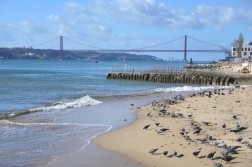
Lisbon is probably the first place you will visit when you travel in Portugal, and maybe the last. Lisbon is not only the beginning of your adventure in Portugal, but was also the birthplace of the country we now know as Portugal.
The region surrounding Lisbon has been continuously inhabited since the Neolithic period, so it’s difficult to say when modern Lisbon was first established. Some date it all the way back to the Roman period when the city was known as Ulyssippo, while others consider the year 1147, when Portugal was re-conquered (from the Muslims) by Alfonso I of Portugal, as the beginning of the city as we know it.
Whether you consider it a must-visit tourist destination or one of the most significant societies in Western history, Lisbon is the origin of whatever Portugal means to you.

Rua Augusta (that’s Portuguese for “Augusta Street”) is one of Lisbon’s busiest tourist arteries and runs south from Rossia Square to the Tagus River. A pedestrian street, Augusta Street is lined with shops, eateries and accommodation, such as the Traveller’s House hostel, which I listed among my favorite hostels in the world.

Lisbon is famous for its bright yellow streetcars or “americanos” (they were first imported from America), such as this one seen in front of the Lisbon Cathedral. While Lisbon’s trams only date back to the 19th century, the Lisbon Cathedral can trace its origin to the year 1147, when the city was liberated from its former Muslim rulers.

The Ponte 25 de Abril (25th of April Bridge) is Lisbon’s answer to San Francisco’s Golden Gate, spanning the Tagus River just before it meets the Atlantic Ocean. Opened in 1966, the bridge (whose name commemorates the onset of the Portuguese revolution of 1974) was actually built by the American Bridge Company, the same one that designed the Golden Gate. Ponte 25 de Abril is just over two kilometers in length.

Lisbon is filled with majestic plazas. The Praça do Comércio, pictured above, commemorates the site of the Royal Riberia Palace prior to the 1755 Lisbon earthquake, which destroyed it. Praça do Comércio is located at the southern terminus of Rua Augusta.

One of Lisbon’s features that most delighted me the first time I flew over the city was its uniformly terracotta-colored roofs. No matter why you want to get a bird’s eye view of the Portuguese capital, dozens of Lisbon viewpoints exist. Shown above is the view from my personal favorite, Nossa Senhora do Monte, which is just a 10-minute walk from Praça do Comércio and the surrounding Baixa-Chiado district.

If you automatically think “France” when you think of the Eiffel Tower, a trip to Lisbon might change your thinking. The Elevador de Santa Justa was designed by Raul Mesnier de Ponsard, one of Gustave Eiffel’s apprentices, whose plans for a tower to connect the Baixa district to neighboring Chiado began to take shape in 1900.

Have a free day in Lisbon? Take the #15 tram from Praça do Comercio to Bélem, a historic Lisbon parish located about 4 km west of the city center and just 1 km from the Ponte 25 de Abril. Historically-speaking, Belem is significant because it’s where many Portuguese explorers set off on their seafaring voyages. The ones who set sail after the year 1519 departed from the Bélem Tower, pictured above.

Another must-visit site in Bélem (besides any restaurant that sells pasteís de Bélem, delicious mini custard pies) is the Jerónimos Monastery, which opened in 1601 after more than 100 years of planning, construction and paper permission. After Vasco da Gama returned to the monastery with gold from the New World, the monastery became synonymous with Portuguese expansionism abroad. Even if you aren’t religious, the vast scale of the monastery is sure to invoke God like architectural mastery.

Robert Schrader is a travel writer and photographer who’s been roaming the world independently since 2005, writing for publications such as “CNNGo” and “Shanghaiist” along the way. His blog, Leave Your Daily Hell, provides a mix of travel advice, destination guides and personal essays covering the more esoteric aspects of life as a traveler.








